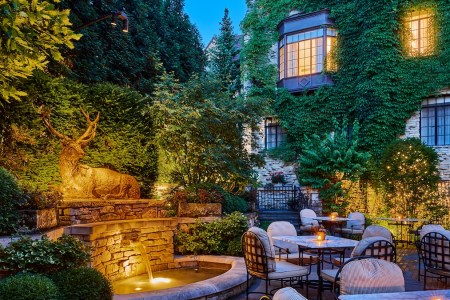In our hyperconnected world, it can sometimes be easy to overlook the museums that stand among us. They are quiet and stout amid what is fleeting and loud. But now, perhaps more than ever, it’s worth planning a visit. They contain our shared history, lessons from the past that can inform the future, not to mention works of remarkable and staggering beauty. Chicago happens to have some of the greatest museums in the country. What’s more, on certain days, they are absolutely free. Here are 11 you should mark on your calendars this season.

The Art Institute of Chicago
Free on Thursday evenings from 5 to 8 p.m., June 6 to September 26
(Other groups, like the military and Chicago teens, are always free. More info here.)
The Art Institute was founded in 1879, and it’s one of the most iconic art museums in the world. It contains works like Georges Seurat’s “Sunday on the Grande Jatte,” Edward Hopper’s “Nighthawks,” Picasso’s “Old Guitarist,” Vincent van Gogh’s “Bedroom” and Georgia O’Keefe’s “Cow’s Skull With Calico.” It’s a highlights tour through art’s major movements — think Impressionism, Cubism, Abstract Expressionism, Modernism, Art Deco, Pop Art and more. Beyond two dimensions, you can cast your gaze upon furniture, masks, armor and antiquities. A single three-hour block is a perfect introduction that will undoubtedly have you coming back for more.
The Museum of Contemporary Art
Illinois residents are free on Tuesdays
(Other groups, like the military and Chicago teens, are always free. More info here.)
Founded in 1967, the Museum of Contemporary Art (MCA) is focused on the work of living artists and is one of the world’s largest museums dedicated to contemporary art. The MCA has a storied past, including solo shows in the 1970s by Roy Lichtenstein, Robert Rauschenberg and Andy Warhol and musical performances by Steve Reich and Philip Glass. In the ‘80s, the museum hosted Jeff Koons’s first solo show and exhibitions by Robert Mapplethorpe. The ‘90s brought the MCA to its current location off Michigan Avenue in a stunning building designed by Berlin architect Josef Paul Kleihues. Since 2000, the museum has shined a light on local artists like Rashid Johnson and Faheem Majeed, through the series 12 x 12 and Chicago Works.

The Field Museum
Illinois residents are free on Wednesdays
(Other groups, like the military and teachers, are always free. More info here.)
Although the Field Museum opened to the public in 1921, it actually grew out of the 1893 World’s Columbian Exhibition. The museum was named after Marshall Field, who donated $1 million to make the Columbian exhibits permanent. It now houses an astonishing 40 million artifacts and specimens. All manner of flora and fauna are represented here, including star dinosaur Sue, the largest and most complete T-Rex yet discovered, and many other fossils, mammals and hominids. There’s also an Egyptian tomb, mummies, a Maori meeting hall and exhibits on Chinese history, Aztecs, Native Americans and Pacific Islanders. The double entendre of the museum’s name is quite fitting: if you can’t be in the field (be it a safari, archaeological dig, mining expedition, ocean or journey afar), you can see much of the world’s diversity and history within one giant, statuesque building right here in the Windy City.
1400 S. DuSable Lake Shore Drive

The Shedd Aquarium
Free Tuesday evenings 5 to 9 p.m. through August
(More information here)
The Shedd Aquarium was founded in 1924 by John Shedd, former president of Marshall Field and Company, and it’s a marvel of marine and freshwater life right off Lake Michigan. It was built by the architecture firm Graham, Anderson, Probst & White, well-known masters of the Beaux-Arts style who also designed the Field Museum and Wrigley building. Inside the marble-clad exterior are all manner of aquatic life, from an active Caribbean reef system to sea otters and jellyfish to touch encounters with stingrays and sturgeons. The Abbott Oceanarium plays host to a three-million gallon tank that’s home to Beluga whales (the museum is one of only six accredited organizations in the United States that cares for belugas). In addition to maintaining the aquarium, the Shedd is actively involved in research and marine animal rescue work around the world.
1200 S. DuSable Lake Shore Drive
The 8 Best Spots to Dine Al Fresco in Chicago
Patio season has finally arrived. Here’s how to do it right.Adler Planetarium
Free for Illinois residents (with proof of residency) every Wednesday evening from 4 to 10 p.m.
The Adler sits on the museum campus and, at nearly 100 years old, is also the first planetarium in the Western Hemisphere. In addition to exhibits about the magic of our skies — from eclipses to telescopes to the “Mission Moon” featuring Wisconsin native, NASA Captain James A. Lovell, Jr. — the planetarium has seven different Sky Shows. In “Destination Solar System,” viewers travel through millions of miles of space; “Imagine the Moon” explores our relationship with our closest celestial object; and the perennial planetarium rite of passage “Dark Side of the Moon,” which is now a 50th-anniversary edition. The Adler is also home to Doane Observatory, which allows viewers to see stars trillions of miles away.
1300 S. DuSable Lake Shore Drive

The Swedish American Museum
Admission is free for all on the second Tuesday of the month. Members and children under the age of one are always free.
This gem of a museum occupies a 28,000-square-foot space in the heart of Andersonville, an area known as the “Little Sweden” of Chicago. In fact, in 1900, Chicago had the highest population of Swedes outside of Stockholm, and in the mid 1800s, Swedish farmers were harvesting cherries on land now criss-crossed by city streets. The museum, founded in 1976 and officially opened by none other than His Majesty Carl XVI Gustaf, King of Sweden, honors the lives of Swedish immigrants who made the journey to America with their steamer trunks and dreams of prosperity and freedom. (None other than Charles Rudolph Walgreen, founder of the drug stores bearing his name, was a second-generation Swedish Chicagoan.) In addition to its charming displays and attentive staff dedicated to celebrating how Swedish culture, customs and traditions have helped Chicago grow into the vibrant city it is today, the museum boasts a fabulous cafe and well-stocked gift shop with Swedish foods, candies, toys, books and other imported products.

The Chicago History Museum
Admission is free for Illinois residents on August 28. Kids 12 and younger are always free.
It’s sometimes easy to forget what a pivotal role Chicago has played in U.S. history over the centuries — Abraham Lincoln’s nomination in the Wigwam and FDR’s in Chicago Stadium; the 1968 Convention; the architecture of Frank Lloyd Wright; the commercial power of Sears and Montgomery Ward and Crate and Barrel; its days as “hog butcher to the world;” the World’s Columbian Exposition; contributions to civil rights; blues music; the nuclear bomb; the birth control pill; the first cellular phone; the dominant Bulls and Original Six Blackhawks and iconic Cubs. The list is long and compelling, and much of it can be surveyed at this excellent museum in Lincoln Park. Current special exhibits include “City on Fire” and “Designing for Change: Chicago Protest Art of the 1960s-70s.”

National Museum of Mexican Art
Always free
The National Museum of Mexican Art, located in Pilsen, houses one of the country’s largest Mexican art collections, featuring more than 18,000 artifacts from ancient Mexico to the present. It was founded by Carlos Tortolero in 1982 as the Mexican Fine Arts Center, and it moved into its current 48,000 square foot location in 2001. The museum is nothing if not transportive, from the never-before-exhibited statues of women warriors, goddesses and governors from approximately 1500 BCE to 1400 CE (“Ancient Huasteca Women”) to colorful beadwork and religious artifacts to Jesus Helguera’s arresting painting “The Legend of the Volcanoes.” There’s something surprising, beautiful, thought-provoking or spiritual at every turn. Also on exhibit are works from Mexican and Chicago artists from the World’s Columbian Exhibition, Mariachi music and the annual Yollocalli Arts Reach, which features work from youth artists.

DuSable Museum of African American History
Admission is free on Wednesdays
(Other groups, including Illinois teachers, students K-12, the military and first responders are always free. More info here.)
The DuSable Museum, located in Washington Park on the South Side of Chicago, began life as the Ebony Museum of Negro History and Art in 1961. Founded by artist/educator/activist Dr. Margaret Taylor Burroughs and her husband Charles Burroughs, it was renamed in 2021 to honor Jean-Baptiste Pointe DuSable, the Haitian-born explorer and founder of Chicago. It also holds the distinction of being the nation’s first independent museum celebrating Black culture. The Museum’s current exhibitions cover a wide range of topics, from Dutch Colonial Slavery to Chicago Mayor Harold Washington to the experience of the 8th Infantry Illinois National Guard from 1895 to 1941. “Freedom: Origin and Journey” is dedicated to the thousands of lives given in the name of freedom and equality, and features chilling artifacts from the slave trade and segregation. “Art of Our Storytellers: Selections From the Johnson Publishing Collection” is a spellbinding array of paintings and sculpture from the headquarters of the Johnson Publishing Company (of Ebony and Jet fame). And speaking of firsts, on the day of my visit, the museum was hosting the Chicago screening of Tolton Speaks, a documentary about Father Augustus Tolton, the first American priest of African descent and another legendary Chicagoan.

The Griffin Museum of Science and Industry
The MSI adds free days throughout the year. Visit this page to learn more.
When you visit other Chicago museums, nearly all of them make reference (often with large exhibits) to the World’s Fair. But when you visit the MSI, you actually visit a part of the 1893 World’s Columbian Exposition. It’s the only building constructed for the Exposition’s “White City” that remains at the site on the South Side of Chicago. Originally the fair’s Palace of Fine Arts, it’s now the Western Hemisphere’s largest science museum. Within the 400,000 square-foot space you’ll find an indoor tornado, 727 airplane, a “working” coal mine, expansive model train sets, displays of the human body and a pristinely restored German U-Boat (U-505). At every turn there are marvels that spark the imagination and grow knowledge. The Henry Crown Space Center now includes capsules from the Apollo program to a SpaceX Dragon Capsule. A new exhibit, “007 Science: Inventing the World of James Bond,” focuses on the science and technology behind the world’s longest-running movie franchise (through October 27). And everything mentioned here only scratches the surface of what’s in this incredible museum.
5700 S. DuSable Lake Shore Drive

Chicago Botanic Garden
The Botanic Garden has free days throughout the year. Visit this page to learn more.
Spanning nearly 400 acres north of Chicago on the outskirts of Glencoe, the Chicago Botanic Garden is a meticulously planned and cared-for expanse of natural beauty complemented by notable architecture. It traces its origins to the Chicago Horticultural Society in 1890, with its current location dating back to 1972. The Garden has one of the largest memberships of any U.S. botanic garden and is one of only 17 public gardens accredited by the American Association of Museums. In addition to ambitious special exhibitions throughout the year (the Orchid Show, holiday Lightscape and the Night of 1000 Jack-o’-Lanterns to name a few favorites), it’s easy to lose yourself simply walking through the 28 different gardens and buildings full of rare and beautiful plants, flowers, butterflies and botanical art. The Japanese Garden is utterly captivating and the bonsai collection (on display from April to mid-October) is among the largest in the country.
This article was featured in the InsideHook Chicago newsletter. Sign up now for more from the Windy City.
























